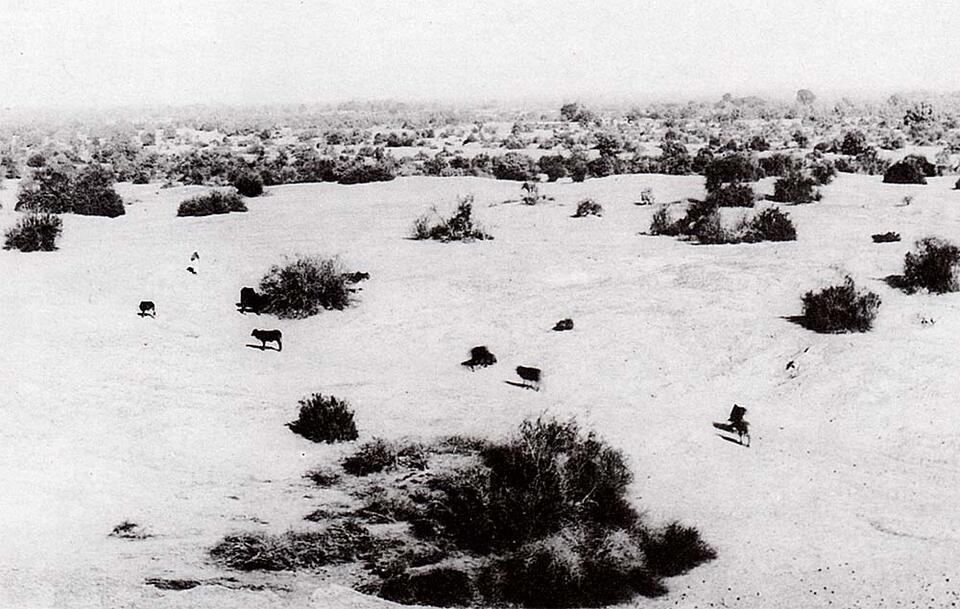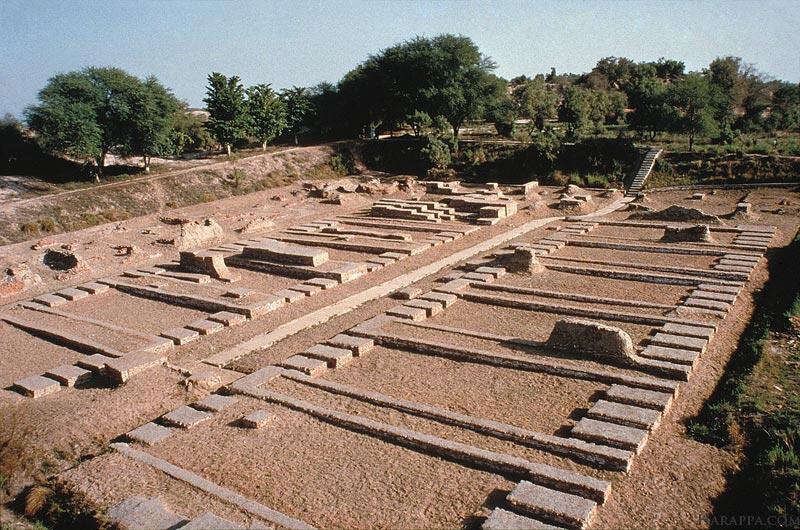In her article about the discovery of the Indus civilization Are archaeological discoveries like scientific discoveries? The curious case of the Indus civilization, Nayanjot Lahiri writes: "Unlike accounts about discoveries which are retrospectively told as neat narratives by their discoverers, this one cannot be written around a hero and one who knew the significance of what he was about to uncover. Rather, the credit for unearthing the Indus civilization goes to several archaeologists, most of whom were connected in various ways with the Archaeological Survey of India [ASI], a government department of the British Raj. Equally, some of them quite unexpectedly, and without any planning on their part, discovered clues which would eventually change the way the Indian past was visualized. In some ways, this fits in with what histories of science have increasingly revealed, that scientific discoveries are infinitely more haphazard than they appear in received accounts of scientific genius (Waller 2002)."1
Welcome to the start of new 1,000-page photographic series on the Discovery and Earliest Excavations at Harappa 1829-1940.
We begin the series with a six-part section Harappa Before Excavations which goes through the earliest clues as they were collected and published in books and articles by various British and Indian visitors to Harappa between 1829 and 1917. These are the pieces that led to the recognition of the existence of a long-lost civilization by John Marshall, then Director-General of the ASI. Lahiri notes: "He came to India as the Director General of the Archaeological Survey of India (ASI) in 1902. Before that, while preparing for his departure, he had examined many objects of Indian origin in England, including the three British Museum seals of Harappa, inscribed in an unknown script. It was, however, only in 1924 that Marshall would preside over the discovery of the Indus civilization, a discovery which had much to do with the sorts of seals that he had first examined more than 22 years before. Marshall’s, in fact, is a classic case of ‘the slow hunch’. Here was an archaeologist who had since the early 1900s intuitively imagined that there was an unknown archaeological canvas which preceded what was then considered to be the beginning of the subcontinent’s historical past, and yet, this precognition fructified in a positive sense many decades later."2
That said, unlike the splash created by the discovery of Tutankhamen's Tomb the same year as Marshall published the finds at Harappa and Mohenjo-daro, the excavations at these Harappan cities were led and documented by Indian archaeologists. As a result, they were more collaborative and included local themes and participants compared with other Bronze Age cities and places unearthed around the world during the late 19th and the early 20th centuries by Western archaeologists. Indian archaeologists were at the heart of most early Indus discoveries and excavations. So, whereas in Egypt and Iraq the gap of four thousand years between past and present was immense, the objects coming up from the ground in Harappa and Mohenjo-daro seemed very familiar indeed, from lotas and lingams to chess pieces, bangles and inkpots.
The aim of this series is to present the clues that led to the understanding of an ancient Indus civilization between 2500 and 1900 BCE as closely as possible to the original formats, words, and images as they appeared written and interpreted by Indian, British and other archaeologists, in a story that foregrounds the roles of these individuals as they recognized anomalous fragments of India's past.
The main section First Excavations at Harappa will comprise approximately 1,000 photographs from the original Archaeological Survey of India excavations from 1921, 1923-24, followed by subsequent seasons at the site through 1940. Each published image is accompanied by relevant text from contemporary ASI reports by archaeologists including Daya Ram Sahni, Madho Sarup Vats, and Sir John Marshall, as well as news reports and other eyewitnesses and contemporary experts.
The visual chronicle Harappa: First Excavations is being released in celebration of the 100th anniversary of the first excavations at Harappa led by Rai Bahadur Daya Ram Sahni in January 1921. The slides cover the seasons that followed almost each year until 1940. Many of these images were published in the various annual reports and a major publication on Harappa published by M. S. Vats in 1940. The original glass negatives are archived in the photography section of the Archaeological Survey of India offices in New Delhi, India and new negatives were made along with new prints, including copies that were provided to the Harappa Archaeological Research Project (HARP) for the library at the Harappa Museum in Harappa, Punjab, Pakistan.
Dr. Jonathan Mark Kenoyer is co-director and field director of the Harappa Archaeological Research Project, which began new excavations and surveys at Harappa in 1986 under the leadership of the late Dr. George F. Dales in collaboration with the Department of Archaeology and Museums, Government of Pakistan. The original photograph captions have been provided along with selected annotations and revised descriptions based on subsequent studies by Kenoyer, various members of the HARP team and other scholars. This is a continuing process.
Our objective is to provide details about the images and the related excavation reports in a weekly schedule over the next two years, 2021-2023. By means of the archival photographs, we will recreate a visual journey through the archaeological discovery of Harappa from its very first excavations in January 1921 through to 1940. The content will be published on this site, as well as our social media accounts - the Ancient Indus Facebook page and @Ancient_Indus on Twitter.
The section is being curated by Dr. Nadine Zubair and Omar Khan. Dr. Zubair studied archaeology at the University of Peshawar before joining UPenn as a student of Dr. Gregory Possehl. This project combines her interests in early 20th century photographic archives and Harappan archaeology with a desire to make this information accessible to diverse audiences. Omar Khan is the founder of Harappa.com and author of two books on early visual imagery of the subcontinent.
"The overriding difficulty of the archaeological photographer is to tell the truth," wrote Sir Mortimer Wheeler, one of the excavators of Harappa and Mohenjo-daro, in his book Archaeology from the Earth (1954, p. 200). As we dust off these photographs from the archives that are based on the hard work of labourers and archaeologists digging deeply into mounds untouched for millennia, it is worth considering how they were used by archaeologists and their photographers to tell a story.
Nayanjot Lahiri concludes in her gripping book Finding Forgotten Cities How the Indus Civilization was Discovered (Penguin India, 2005): "The real heroes of this story of the discovery of the Indus civilization were such individuals–a discerning archaeologist like Sahni and a brilliant one like Banerji, who had within a few years of each other uncovered the relics entombed in Harappa and Mohenjo-daro respectively; alongside, a debutant like Vats who first saw cultural congruences between the two cities which went beyond the enigmatic seals, and which veterans like Sahni and Banerji had failed to notice; the unfortunate linguist-turned-explorer Tessitori, who excavated seals of Harappan antiquity from the earth of Kalibangan but never lived to tell the tale; all kinds of government officials who were also self-taught archaeologists, such as Hugh Buller in Baluchistan, Carter in Sindh, and Malik Muhammad in Bahawalpur.
"Men such as these on their own discovered the 'aberrations' – the evidence that was at odds with what was known about India's past. And presiding over the process was a slow-moving, cautious, academically inclined Marshall who, once he got down to grappling with the puzzle of the Indus, put together the pieces with visionary insight even if, rather strangely, without having visited the cities from where they came" (p. 362-3).
For those of you eager to get ahead of this release, or who want more of the story of the excavations at Harappa, read the archaeologist Gregory H. Possehl's essay A Short History of Archaeological Discovery at Harappa from the volume Harappa Excavations 1986-1990 A Multidisciplinary Approach to Third Millennium Urbanism, edited by Richard H. Meadow. It gives an accurate chronological account of the work and people each year at Harappa, one of the world's oldest continuously settled cities in Punjab, Pakistan some twenty miles from the border with India. [The PDF of the article is attached below] Possehl also wrote an exhaustive and fascinating account of the discovery of the ancient Indus civilization, filled with primary materials, images, even his sketches of other archaeologists, in the thousand-page tome Indus Age The Beginnings (University of Pennsylvania Press/Oxford India, 1999).
Images:
1. Harappa, general view of Mound F before excavations, from the southwest. Courtesy of the Archaeological Survey of India, Punjab Photographic Volumes 503/86, in Possehl, Indus Age: The Beginnings.
2. Mound F, Harappa.
1. Nayanjot Lahiri (2017) Are archaeological discoveries like scientific discoveries? The curious case of the Indus civilization, World Archaeology, 49:2, 174-175, DOI: 10.1080/00438243.2016.1264310↩
2. Ibid., p 176-177.↩







